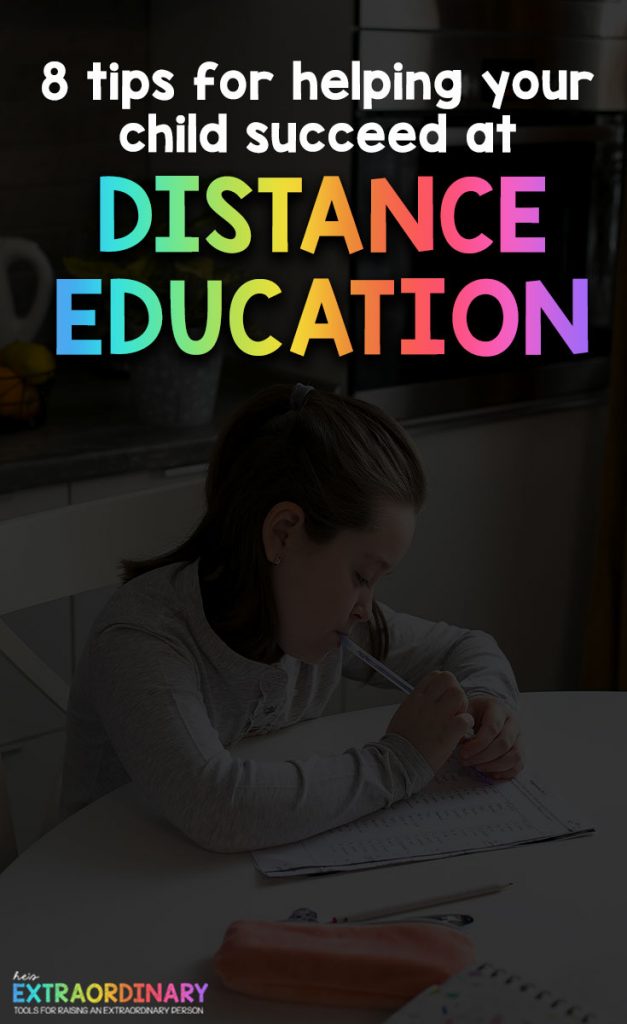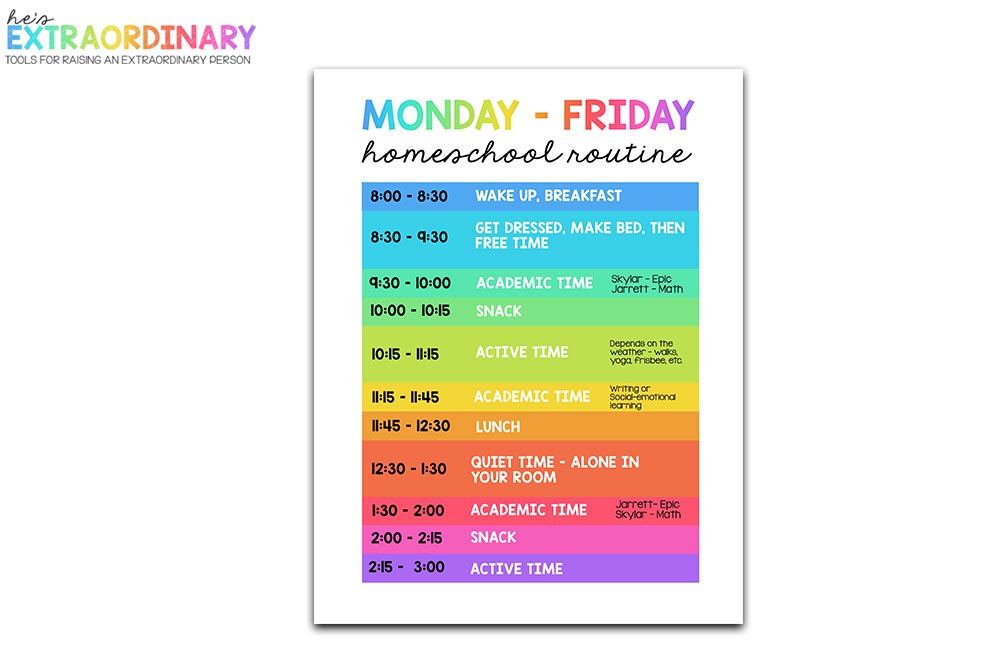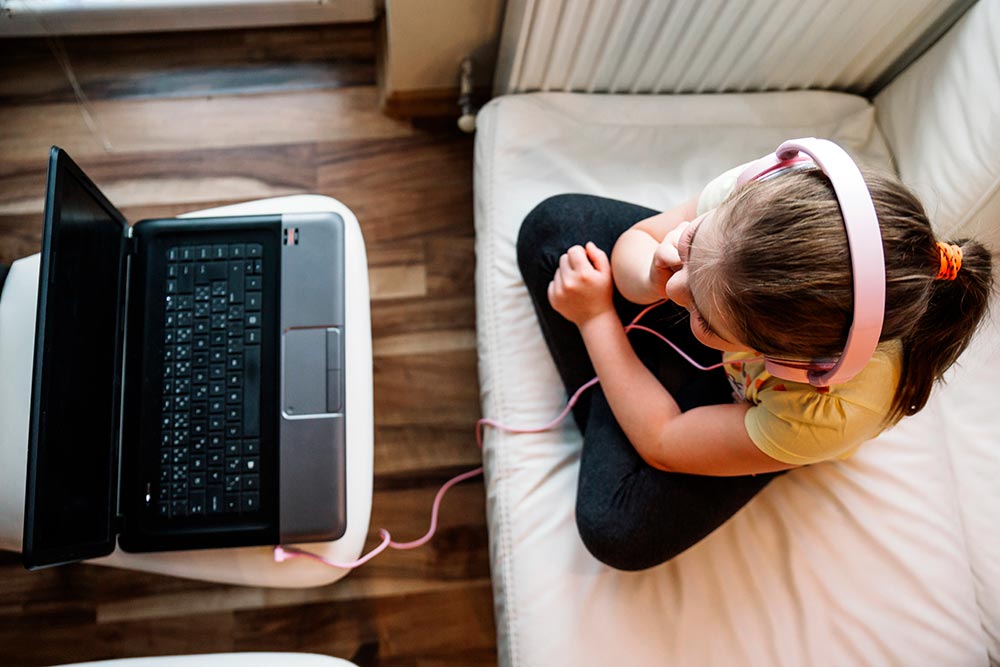Tips for Successful Online Learning During the Pandemic
What’s inside this article: 8 tips to help your child find success during online learning, sample routines, eliminating distractions, a list of great educational apps for kids, and links to printable learning resources.
Disclaimer: This page contains affiliate links.
Update, Jan 2022: Due to the recent surge of cases from the omicron virus, many schools are returning to an online learning model temporarily. I’ve reviewed and updated this article to provide relevant and up-to-date information.
Parents all over the world are entering uncharted territory. I know many of you are trying to work at home, while also homeschooling your child or supporting them through online education with their school district.
How can you help your child find success through distance learning?
I’ve got some tips for you. I also have some printables at the end of this post.
Over the last two years, we’ve gone through several periods of online learning due to school closures, and faced a lot of hurdles along the way. However, I’ve also found a lot of ways to help my kids learn from home successfully, and I want to share that knowledge.
Give Your Child Some Credit
Before I get into tips for helping them learn through distance learning, this needs to be said. Give your child some credit right now!
Right now, our kids lives are turned upside down.
They’re stuck inside without fully understanding why. They suddenly can’t go to school, see their friends, or their family.
Their entire routine changed overnight. Now there are all these new rules they’ve never had to follow before.
Their minds are probably racing, even if they aren’t acting like it, as they try to process all the changes around them.
Children need consistency and predictability to thrive.
Expect behavior problems, expect them to be more emotional than usual, expect some resistance. That’s normal right now.

Tips for Successful Online Learning During the Pandemic
Okay on to the tips.
1. Establish Your Routine
I can’t stress this enough.
I just mentioned childrens’ strong need for structure and predictability. Establish a new routine for them right away. The sooner they learn it and can begin settling into this new normal, the better.
It doesn’t need to be a super rigid routine where you’re devoting all your time to teaching them instead of parenting. Just establish some order in your home.
Make a visual schedule and display it for your kids.
Depending on their age, you can include visuals or just words.
Here is ours from the beginning of the pandemic:

There are a few things worth noticing in our routine that I’m going to mention as the next few tips.
In 2021, the teachers sent out their own schedules because they’d moved to a virtual classroom model. However, these tips below still applied and many teachers incorporated some of this into their scheduling anyways. Although if your child’s teacher has a schedule that isn’t working for your child, reach out the let them know. Let them know you’re going to make some modifications to support their learning and wellbeing.
2. Don’t Stack Challenging or Unpreferred Activities
For most kids, being home is where they can relax and enjoy themselves most of the time.
Adding extra academic time is challenging for simply that reason alone.
Always schedule something fun right after academic time. Don’t expect them to do two hard tasks in a row. It will lead to heightened frustration levels and they won’t be as productive.
You’ll notice on our schedule that after every block of academic time, there are two things:
- An opportunity to eat (either a snack or lunch)
- A preferred activity – active time, free time, or quiet time (which is when the kids have their screen time)
It’s not a coincidence that their days are arranged in this way.
In lower elementary, most kids need some type of brain break after about 20 minutes of sustained focus on a single task. Older children are able to focus longer but still need breaks. Also, if your child has ADHD, it’s understandable if they need more frequent breaks throughout the day.
3. Kids Don’t Need to Spend That Much Time Working During Online Learning
Our school e-mailed us guidelines for how much work kids should be doing every day.
For those in elementary school, they only need about 1 hour of academic time each day. For high school students, they recommend 3 hours per subject per week.
A lot of our kids’ learning happens naturally through their life experiences, and their play, etc. You don’t need to provide 6 hours of instruction to your child every day.
4. Kids DO Need Lots of Active Time
Kids actually need between 1.5 and 2 hours of moderate to vigorous exercise per day. If your child is an energetic sensory seeker, they might need more.
It’s harder than ever to get out and be active. Many places initially closed down parks, playgrounds, and trails. Thankfully, we know now that the virus isn’t usually transmitted outside and there’s lots of space outside to social distance, so get out as often as you can.
You’ll notice on our schedule, we have 1 hour and 45 minutes of active time every day, plus sometimes we extended the afternoon one.
How We’re Staying Active During the Pandemic
- Walking in the woods & neighborhood – We’ve been taking almost daily walks and exploring the woods around our house. We even found a couple of waterfalls nearby. Any time the weather is nice, this is what we’re doing.
- I initially bought this mini trampoline for our living room – The kids used it every day, it was a saviour in our household. Later, I went on to purchase a 15 ft trampoline with a net for our back yard, and a treadmill. That was for my benefit as well as the kids’.
- Cosmic Kids Yoga is a phenomenal Youtube channel with loads of themed yoga activities for kids. The videos are so much fun on days when we can’t go outside.
- This 7 Minute HIIT workout is another great way to get your kids moving while you’re stuck inside the house whether it’s a bad weather day or you’re required to isolate.
5. Do The Most Challenging Academic Work in The Morning
We like to get whatever the kids find the hardest over with first thing in the morning. It seems to be easiest for them to focus on tasks at this time.
It’s not necessarily that it’s hard work or material they dislike, it’s just easier for them to give their full effort in the morning.
For example, my son actually enjoys math but it requires a sustained focus that isn’t always easy for him (even in the mornings) so he does his math work in the morning.
If the schedule provided by the teacher doesn’t coincide with this, we switch assignments around. I’ve found teachers to be extremely accommodating over the past couple of years if you reach out.
6. Eliminate Distractions
You’d be surprised how many distractions there are at home.
Even a child who focuses well at school might have trouble ignoring distractions at home. Since the distractions in your house are more enticing than the ones at school.
The family dog or cat, all the child’s toys and favorite activities, the TV, you. These things are all at home, but not at school.
We’ve been dealing with a lot of trial and error in this category and are finally figuring things out.
For example, my oldest needs to wear headphones while my youngest does math because she counts out loud and it’s distracting.
They can’t do writing at the same table together because if one of them needs to erase something it shakes the table too much for the other.
My daughter needs to be away from the TV completely because she will slowly gravitate towards it as if she’s stuck in its orbit.
The dog’s a welcome distraction for everyone. Who wouldn’t choose a cuddle over math questions? Keeping them out of their learning environment as much as possible helps.
7. When Your Child Encounters Issues, Accommodate Them
I’ve always had to work with the school on accommodating my oldest’s needs and now I’m doing it at home – and it’s probably going to benefit him when he does go back to school since I’m getting new insights into his academic challenges.
I realized that he gets overwhelmed when there are a lot of questions on a single page, even if he doesn’t need to answer them all or they’re something he’s really good at.
He does a lot better when I use a larger font and only put 2 or 3 questions on the page, and then he’ll do multiple pages of work.
This change makes him feel productive and accomplished, rather than overwhelmed.
Visual supports are another helpful way of accommodating students. Print and display learning resources like multiplication charts, sight words, and other educational posters can help them complete their work independently.
8. Use Educational Apps and Websites to Make Online Learning Easier
I’m not a teacher.
I can make up activities that offer practice for my kids but when it comes to actually teaching new material, I don’t have the training.
Sure, I can do a pretty good job at a lot of things but other things I can’t.
My daughter is dyslexic and receives a considerable amount of 1 on 1 support at school, including someone to read all of her work to her and to scribe all of her answers for her.
We’ve tried many different educational apps and tools to supplement the kids’ learning.
- Khan Academy Kids – This app is 100% free – there are no ads, no in-app purchases. It’s just full of lessons and games that teach math and literacy skills. It’s great for kids aged 4-8.
- Khan Academy – For upper elementary and high school students, the Khan Academy website has a lot to offer. Their instructional videos for different math concepts are very easy to follow and I’ve been using them rather than trying to explain different mathematic operations to my oldest.
- ABC Mouse –You can set up 3 child accounts with one subscription without needing to pay extra. My two youngest are enjoying the app and choosing to play during their free time, which is a bonus. However, it didn’t benefit my daughter for learning new literacy skills because she’d just repeat the mini games that are already easy for her.
- Elephant Learning – Elephant Learning is a fantastic math app. They guarantee that your child will learn one year of math in 90 days by playing their app for only 30 minutes per week. My kids made significant progress using this app. This app is the most expensive on the list but you may be able to qualify for a scholarship for your child. You can apply for the scholarship during the sign-up process and you get an answer immediately.
- Epic! – This is my favorite app – we’ve had a subscription for about 2 years now. Epic has over 25,000 children’s ebooks available. We use this so much – to put it into perspective, my 4-year-old read over 150 books in the last month. They offer 1 month free when you sign up. Theres a large library of audiobooks as well which is great for children who aren’t independant readers just yet.
- Blooket – Blooket is a great website that turns practice questions into a game. After signing up for a free account, you can visit the discover page and search for the material you want your child to practice. There are tons of question sets already on there, many made by teachers. Your child answers questions, gets points, and uses those points to play a game. Our favorite game is Tower of Defense. Everything is completely free.


